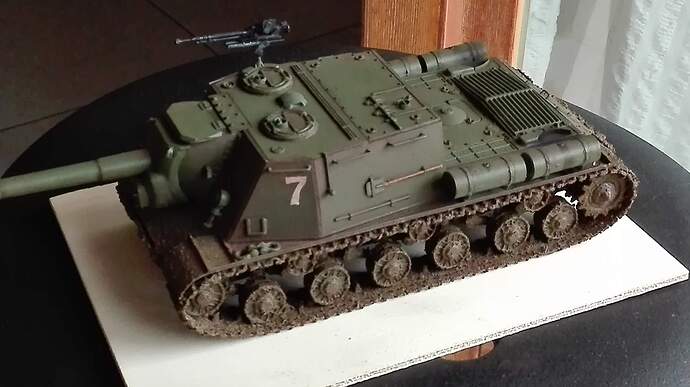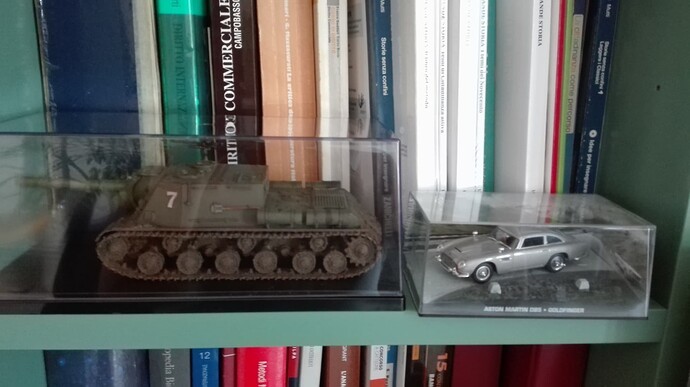The plastic display boxes are one way to protect the model from dust although it will take up a little more room on a shelf than the kit alone.
If you happen to have an Ikea nearby, check out the Detolf glass cabinet. They are $60 each and have four shelves roughly 14x14 inches each. I can get about 3 1/35 tanks per shelf. I don’t think you can buy the glass itself for that much if you tried to build your own; glass and clear acrylic sheets are ridiculously expensive. Enterprising types can rig extra shelves or even combine two units into one wider case. I have 3 and plan at least 2 more. I also have one of their Vittsjo 3-shelf displays which will be used for my bigger kits such as my armored railcars, boats, and submarines. It isn’t enclosed (it was meant to hold dishes and such) but I have a plan for dust-proofing it.
Unfortunately, I have literally zero space for cabinets.
Probably I can mount some shelves.
I have built shelves in my PC room, but you can only make them so deep so some stuff won’t fit. Vehicles are usually okay but I also build 1/32 aircraft and they are on 16" deep shelves and that eats up room space as well as wall space.
Maybe I am going paranoid, but I keep staring at the model and cannot help thinking that there’s something wrong with the pigment color tone and how it contrasts with the caked mud on the bottom of the tank.
It could pass as rust, or just another layer of “different” dirt, but it still looks odd to me sometimes.
As usual it is difficult to take pictures, but here’s another, do you think it looks natural?
1 Like
Add a light touch of a darker brown over the pigment on the upper parts. Just a very light touch to blend a bit.
I used burnt umber from Vallejo, it looked pretty dark in the can…which one should I use?
Tweaking the appearance slightly or not is a matter of personal taste. There’s nothing “wrong” with the model’s appearance. The JSU looks excellent as is and I would be happy with the model on my build shelf. That’s honest from the heart, Nightgaunt.
Honestly, I suggest building a new project and after completing it, look over the JSU and decide if you want to tweak it. Doing another project will help gain more hands on experience before deciding on or proceeding with any changes to the JSU.
Wishing you the best and much fun on the next model  Please post a build thread for it.
Please post a build thread for it.
I feel you’re right, maybe I should just start on the KV-2 next week and look back at the ISU after some time.
I just hope that the wet cotton swab will be enough to remove the pigment in case I want to re-touch it. Do you have any experience with them?
About the pigments, I thought that an excellent one for weathering soviet olive green would be the Vallejo faded olive green pigment, would it be good for streaking?
One of the keys to weathering to show dust and dirt with pigments and or the AB is to do so in a way that is somewhat random but at the same time making sure that it makes sense. There will be a greater concentration of dust etc. around raised detail. There will also be dust overall but less so in areas where there is high traffic from the crew entering and exiting the vehicle where it would be worn off so to speak. Best bet is to look at photos of the real thing. Also keep in mind that as the vehicle moves the dust rises and tends to accumulate a bit higher up on the rear of the vehicle. Again photos of the real thing will help. You can also just observe almost any type of heavy equipment that you might see about and get a good idea from them as well. Good luck.
I agree with @Armor_Buff i keep looking at my t-54 which I moved on from after a filter. I love the way it looks, easily my best effort to date, but I know my skills right now aren’t where they need to be to weather. So I am going to put it away for now and move onto other stuff. One day when I have more practice under my belt I’ll come back to it and do pigments, dot filter and such.
FWIW you JSU-152 is excellent, especially for a first ever build. You are well on your way. The worst thing I think you can do is push the envelope and ruin what you are happy with. I like to try one new skill on each build and try to do it well. The good news is once you pick up that skill you can apply it to old models.
2 Likes
Nightgaunt, starting the KV-2 next week and looking back at the ISU after some time is the smart decision in my opinion.
The KV-2 with the tall turret sides is a nearly perfect practice field for vertical streaking with oil dot filter techniques. Pastel chalk or pigments also etc. The KV style hull is nice sized with many open areas ideal for practicing techniques.
Regarding retouching with wet cotton swabs or removing pigments etc, I grind pastel chalk for my pigment dust. That’s easy enough to remove or tone down, I imagine the store bought pigments are similar. I’ve used a very light flat coat in the past and pastels greatly tone down. I don’t know if that would directly apply to pigments.
Regarding, Vallejo faded olive green pigment, would it be good for streaking?
Regarding pigments or chalk dust etc for streaking, I much prefer an oil dot filter on a gloss surface for streaking. Other folks may feel differently. It’s one of those things each modeler will need to try and decide accordingly.
Most of the weathering, I do gets built in with shadow painting, washes & dry brushing. Oil dot filters for streaking, flat coat and just a little chalk dust at the end. Here’s my thoughts on the process Old School Shadow Painting Finishing
This thread has a lot of great info and details on how to approach using pigments etc well worth a good study.
Chris Bryan - How I Paint and Weather SBS
Finally I found a home for the Beast Killer, I hope Bond won’t mind having it on his driveway:
3 Likes
The barrel end, as in the area between the caliber sized circle of the bore and the larger circle made by the outside of the barrel, is one thing. Check if there is any soot or blackening a quarter of an inch down the outside of the barrel.
Blackened barrels maybe a foot down the outside of the barrel, nice and even on reverse angles on the muzzle brake simply does not happen.
The projectile leaves a Pz IV barrel at more than 2400 ft/s and the gas jet pushing it out of the hole is going forward in the hole in the air created by the projectile. There is no available force or physical phenomenon that will curve this gas jet backwards around a brake less muzzle.
With muzzle brakes there is a slight difference since they turn the jet sideways or even slightly backwards but the dirty gas would still be travelling at very high speed and thus be unable to tarnish surfaces beside the trajectory of the gas jet.
The insides of the baffles in the muzzle brake will get dirty, no doubt about it.

Sherman E8 with muzzle brake, firing in slow motion
The later part of the video shows a Soviet AT-gun with a good view of how the muzzle brake has dirtied on the outside.
Nowhere even remotely close to the ‘dipped in the jar of tar’ artistic muzzle brakes …
The video also shows that big ass shell getting deflected by some water melons, go figure …


